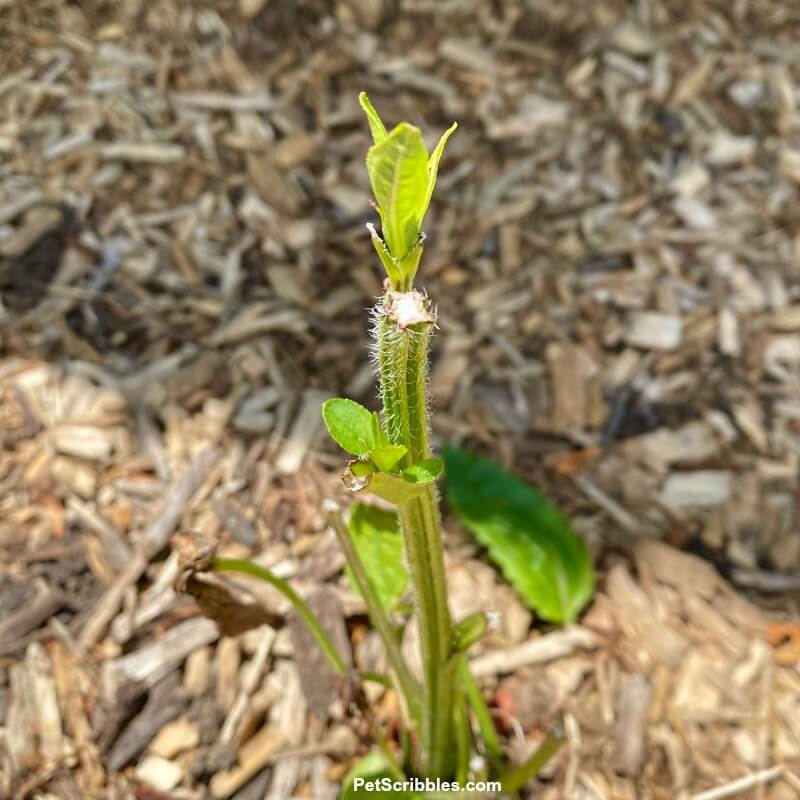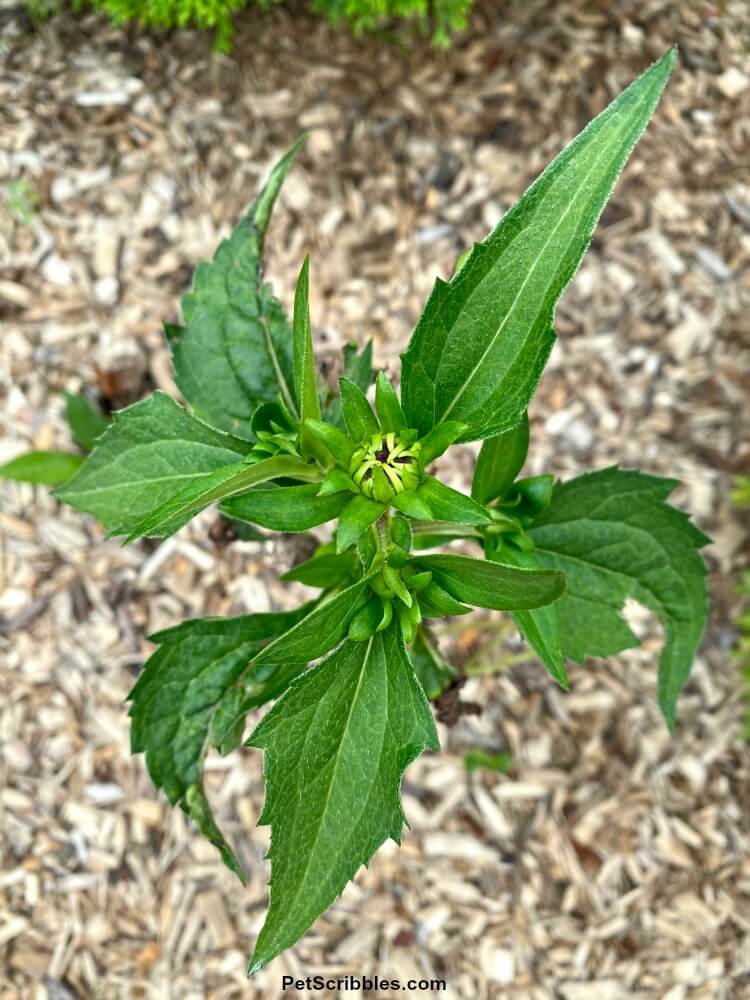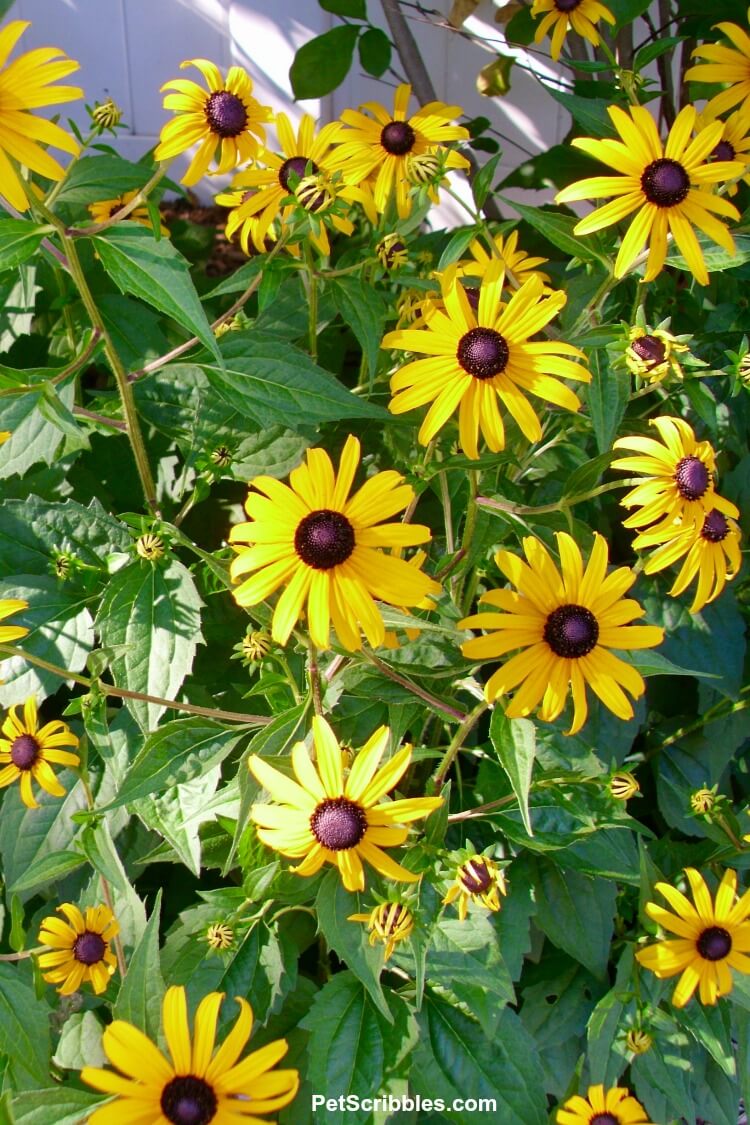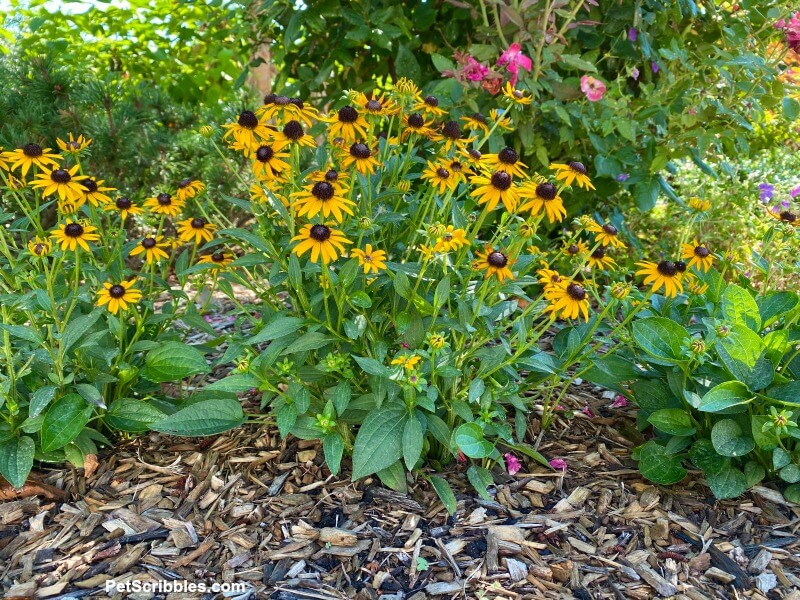Rudbeckia fulgida Goldsturm Black Eyed Susan glows in the landscape! Handles heat, humidity and clay soil, and blooms mid-Summer into Fall. Learn the pros and cons in this guide.

Table of Contents
- Are Black Eyed Susans perennials?
- The perennial version of Black Eyed Susan is Rudbeckia fulgida
- The origins of Rudbeckia fulgida Goldsturm Black Eyed Susans
- Rudbeckia fulgida Goldsturm today
- Benefits and Features
- Rabbits love my Goldsturm Black Eyed Susans
- Black Eyed Susan flowers, leaves and stems
- Rudbeckia fulgida Goldsturm Black Eyed Susan care
- Does it spread?
- Is this variety of Black Eyed Susan invasive?
- Pinching and Deadheading Black Eyed Susans
- Dividing and Transplanting Black Eyed Susans
- Winter into Spring
- Can you grow Rudbeckia fulgida Goldsturm from seed?
- Goldsturm Black Eyed Susan seeds
- Rudbeckia fulgida Goldsturm companion plants
- Are there compact varieties of Black Eyed Susans?
- Conclusion
Are Black Eyed Susans perennials?
You know those pretty Black Eyed Susans commonly seen on roadsides and highways?
They are Rudbeckia hirta, and although they self-seed, they are not true perennials. Instead, they are biennials which means they will bloom the first year, but the second year they will spend time rejuvenating themselves before blooming again the third year. (So every other year they bloom, thus called a biennial.)

Some gardeners consider Rudbeckia hirta as short-lived perennials since they do self-seed, and others consider them as annuals. It honestly depends where you live and what your growing conditions are like.
When in doubt, I always say, ask your local garden nursery experts.
The perennial version of Black Eyed Susan is Rudbeckia fulgida
Rudbeckia fulgida is a clump-forming perennial and will return to your garden every year, especially if you leave some of the seedheads in place after blooming for new seedlings to join your existing plants.
One of the most loved perennial varieties of Black Eyed Susans is Rudbeckia fulgida Goldsturm, because of its easy care, its toughness, as well as its beauty.

The origins of Rudbeckia fulgida Goldsturm Black Eyed Susans
Once upon a time in 1937, a man by the name of Heinrich Hagemann saw a gorgeous bunch of Rudbeckia fulgida while visiting a garden in former Czechoslovakia. He took it back to his boss in Germany who just happened to be Karl Foerster, a well-known nurseryman — you might have heard this name before if you grow “Karl Foerster Feather Reed Grass.”
Anyway, they began propagating the plant but then World War II happened. This new Black Eyed Susan variety — called Rudbeckia fulgida Goldsturm — was finally released worldwide in 1949.
Goldsturm — which translates in English to *gold storm* — is a hybrid of the US native Black Eyed Susan.
Which of course got my mind going back and forth like this:
Well, if Rudbeckia Goldsturm was found in the (now) Czech Republic, but developed in Germany, is it still a US native plant? But then again it was all started from the US native Black Eyed Susan, so I guess it is considered a native…
I have given up trying to figure it out, but since everyone appears to say it is a native plant in the United States, I’ll accept it.
But I still want my question answered!

Rudbeckia fulgida Goldsturm today
It took many years for Goldsturm to truly catch on and reach the level of popularity it enjoys today, in part helped along by receiving awards in the 1990s from the Royal Horticultural Society and the Perennial Plant Association.
Today, Rudbeckia fulgida Goldsturm is one of the most popular perennials to grow, whether in home gardens or public parks. Glowing flowers cover each plant, lighting up the landscape.
Popular uses include:
- cottage gardens
- pollinator gardens
- perennial borders
- cut flower gardens
- containers and planters
Goldsturm Black Eyed Susans also look wonderful when planted in drifts or naturalized in large areas.
Benefits and Features
- easy to grow and low-maintenance
- long blooming (mid-Summer into Fall)
- great weather resistance — doesn’t flop over from strong winds or storms
- bees, butterflies (Summer) and birds (Winter) love it
- pest free
- slow spreader and easy to divide
- deer resistant
- supposedly rabbit resistant (keep reading for what my opinion is)
- fabulous plant for clay soils
- handles heat and humidity well
Rabbits love my Goldsturm Black Eyed Susans
I’ve had Goldsturm Black Eyed Susans for years in the backyard. The occasional rabbit sneaked back there under the fence but never touched the Black Eyed Susans.
Until this year.
This Spring, I decided to move the Goldsturms into one of our front yard beds, and even planned to take pictures so I could show you how I transplanted them successfully.
But then the rabbits came.

I call them Pandemic Rabbits. They came from the nearby golf course, closed during the Spring season because of the lockdown. The rabbits must have had a field day over there — pun intended — and multiplied way more than usual.
These rabbits have eaten plants they normally have never eaten in my gardens, including Lantana, Marigolds, Boxwood and Juniper, in addition to my newly-transplanted Black Eyed Susans.

Ugh.
So. If you read somewhere that Rudbeckia fulgida Goldsturm perennials are rabbit resistant, just remember that some rabbits can’t resist them apparently.
I’m now using a combination of Liquid Fence for Deer and Rabbits, plus a sprinkling of Bonide Repels-All. And for a lovely seasoning, my husband adds some cayenne pepper powder onto the plants as well.
The good news is that the plants are growing back:

Slowly.
But I am getting some flowers, despite how sad the lower stems look:

And I ask you: where else are you going to see real images of a disastrous-looking flower? Keepin’ it real, as they say!
Black Eyed Susan flowers, leaves and stems
Rudbeckia Goldsturm Black Eyed Susans are clump-forming perennials, that is to say all the stems appear to come out of the same spot in the ground, with the stems widening slightly the higher they go.
Plants grow between 2 and 3 feet tall, but no worries about the stems flopping over: this is a sturdy plant with an upright habit no matter what the weather is like.

Goldsturm’s leaves and stems are a deep green color, with somewhat of a hairy texture, forming a gorgeous dark background for the masses of flowers.
Goldsturm, like most Black Eyed Susans, has daisy-like flowers with bright yellow-gold petals and dark brown to black centers.
On Rudbeckia Goldsturm, there is one single flower per stem. Each flower measures up to 4 inches in diameter and can bloom for approximately 14 days.
Let me repeat: each flower can be 4 inches across and bloom for 2 weeks.
Wow!
Have a convinced you to plant this yet? (Keep reading so you’re fully informed as I discuss spread and potential invasiveness coming up.)

Rudbeckia fulgida Goldsturm Black Eyed Susan care
Hardiness Zones: 3 to 9
Bloom Time: mid-Summer into Fall
Depending on your location and the weather, Rudbeckia fulgida Goldsturm can bloom well into the Fall season.
Growth rate: fast
Size: between 2 and 3 feet tall and up to 2 feet wide
Sun: full sun but plants can handle some shade
Soil: moist and well-draining
In fact, Rudbeckia fulgida Goldsturm performs best in moist to damp soil, especially in extreme heat.
Water: loves moisture during the growing season; established plants can handle some drought.
More water is appreciated during heat waves or if your Goldsturm are planted in containers.
Pests: nothing serious to worry about
Fertilizer: not necessary, as long as your soil is in good condition.
To keep our soil in good condition, we add composted cow manure to the soil and around our plants every Spring. (Click here to learn more.)
Helpful tip: In hot and humid conditions, powdery mildew can affect Black Eyed Susan leaves.
What will prevent this?
Good air circulation around the plants plus full sun.
What can I do if I’m in a hot and humid area?
1. Make sure to plant your Black Eyed Susans in full sun.
2. Trim out a few stems to loosen up a thick-growing patch of plants.
3. Remove a plant or two from extremely thick patches.
4. Beg Mother Nature to lower the humidity.
Does is spread?
Rudbeckia fulgida Goldsturm spreads slowly, not aggressively at all, by underground rhizomes. (The roots spread underground and sprout up new plants nearby.)
Goldsturm fills in nicely over time, which is what makes it look so pretty in cottage gardens and naturalized settings.
Unwanted plants can be easily dug up. (See section on Dividing and Transplanting below.)
Is this variety of Black Eyed Susan invasive?
There are some gardeners who can’t stand Black Eyed Susans of any variety, thinking they are too invasive in their own gardens. Complaints include the spreading habit plus new seedlings popping up everywhere.
My own opinion — and it is just that: my opinion — is two things may have happened:
Firstly, they allowed all of the seedlings to drop and the plants are so dang happy they just grow like crazy.
Secondly, a different variety of Black Eyed Susan — Rudbeckia hirta that I mentioned at the beginning of this article — is what they’re growing and dealing with. Rudbeckia hirta can be a bit more wild in its spread.
What’s the smartest thing to do?
Do your research before planting any perennials in your gardens, so you know what you’re getting into.
And what is the second smartest thing to do?
If you’ve already planted any variety of Black eyed Susans — and you only want one plant not five of them — the key is to dig down deep enough to remove all of the roots. Just tugging on a plant and removing some of the roots won’t do.
Also remove all seedheads, even deadhead those flowers as they are dying so you have no chance — well, almost no chance — of seedlings.
Remember: Perennials are in it for the long haul, unlike annuals which are finished in a season.

Pinching and Deadheading Black Eyed Susans
It isn’t necessary to pinch back or deadhead Rudbeckia fulgida Goldsturm, however you can if you want to.
Pinching
Pinch back your Goldsturm if you want to keep the flowers at a lower height. Supposedly pinching also makes the plants fuller but I think they look pretty full naturally.
Deadheading
Some gardeners say that deadheading your Black Eyed Susans will encourage additional blooms.
Personally, I haven’t done that, and ours bloom their hearts out from mid-Summer well into the Fall season every year.
Dividing and Transplanting Black Eyed Susans
Black Eyed Susans can be divided in early Spring, if needed.
Rudbeckia Goldsturm is easy to dig up, divide the plants and replant in another area.
If you are trying to remove these plants completely from one area — like I did earlier this Spring — make sure you dig down deep enough to remove all of the roots, otherwise you will have more plants popping up.
The most important thing to remember when transplanting Black Eyed Susans is to give them lots of water in their new spot, especially while they get established.
Check on them daily and give them a little drink, as Goldsturm likes more water than some other varieties of Black Eyed Susans.
Believe me, you’ll notice right away if your new transplants need water, as the entire plant will flop and look horrible.

Beyond wilted.
But Goldsturm Black Eyed Susans will bounce back if that happens…and if the Pandemic Rabbits don’t get to them first!
(Your husband will notice, but you’ll have an answer ready for him which is, “I know, but eventually they will look much better. Just don’t look at them right now.”)
Once Black Eyed Susans are established, their roots will search out water a bit more deeply into the soil so you can water them less.
Winter into Spring
Leaving the brown seedheads in place during the Winter provides texture and interest in the garden, as well as food for birds.
As a result of leaving the seedheads in place, seeds will fall and become new seedlings to replenish — or add — to your existing plants.
Alternatively, you can remove some or all of the seedheads in the Fall if you don’t want new seedlings.
In early Spring, cut the dead stems and leaves to just a few inches and you’ll see new growth sprout up by mid to late Spring.
Can you grow Rudbeckia fulgida Goldsturm from seed?
According to the Missouri Botanical Garden:
Plants do not come true from seed (must be vegetatively propagated). Some nurseries sell seed-grown plants, however, as Goldsturm strain.
What does that mean?
I have no clue.
Honestly, I’ve read that sentence over and over and keep wondering if Goldsturm doesn’t *come true from seed* then why do we talk about how you get more plants from the seeds that fall from the original plants?
Sigh.
Goldsturm Black Eyed Susan seeds
Many reputable companies sell Rudbeckia Goldsturm seeds — like Park Seed, Harris Seeds, American Meadows and Burpee, just to name a few.
So the answer must be “yes” you can grow them from seed.
Rudbeckia fulgida Goldsturm companion plants
Black Eyed Susans work well with so many Summer and Fall flowers, especially flowers with white, purple or blue blooms. Likewise, ornamental grasses look wonderful with them too.
Here is a short list of companion plants for Black Eyed Susans:
- Asters
- Bluebeard (Caryopteris)
- Coneflowers
- Gaillardia (Blanket Flower)
- Geraniums
- Joe Pye Weed
- Liatris (Blazing Star/Gay Feather)
- Ornamental Grasses
- Sedum “Autumn Joy”
- Shasta Daisies
- Russian Sage
Are there compact varieties of Black Eyed Susans?
Yes!
My favorite is Rudbeckia fulgida Little Goldstar.

It is adorable and I’ll be posting an article about it soon.
Conclusion
So. In conclusion, if you can battle the rabbits and handle the seedlings, there are so many benefits to growing Rudbeckia fulgida Goldsturm in your gardens.
The benefits and features far outweigh the frustration, however we all have different levels of what we can handle and what we want from our gardens.
One person’s delight at self-seeding plants (me!) can be another person’s horror at unwanted plants spoiling a garden.
I understand both sides, and hope you do too with this guide.
Happy gardening!

Excellent article. Well written and informative. I enjoy Rudbeckia Fulgida Goldstrom also.
Thanks Susie — I appreciate it very much! I can’t get over what a tough plant it is. The rabbits really chewed up most of the transplanted section I showed above — however — this year they are sprouting up very strong and I’ve been keeping an eye of them, as well as planting some plants rabbits don’t like around the base. Fingers crossed those bunnies move on to greener pastures!